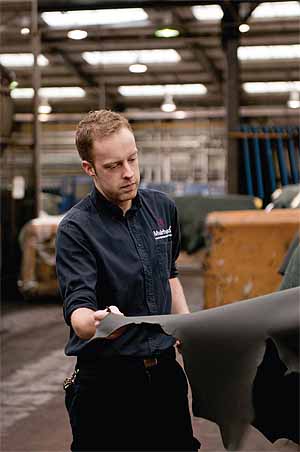UK Leather Federation
A positive leather forecast
Acting as the definitive voice of the UK leather industry, membership-based organisation the UK Leather Federation (UKLF) strives to represent, promote and protect the leather industry in the UK through a focused, authoritative and influential body
First incorporated in 1920 as the United Tanners Federation, the UK Leather Federation (UKLF) has been through a number of name changes and company mergers before it took its current title in 2005. “We became the British Leather Federation in 1950 and merged with the Leather Institute in 1954, at which point we retained the name British Leather Federation. Almost 30 years on, we merged with the British Leather Manufacturers Research Association in 1983 as the British Leather Confederation; this later became BLC, Leather Technology Centre, and finally emerged as the UK Leather Federation in 2005,” confirms Dr Kerry Senior, Director at the UK Leather Federation.

Focused on representing, promoting and protecting the UK leather industry, the UKLF provides support to its members in a number of ways; these include the provision of information, advice and help on a wide range of issues such as existing forthcoming legislation as well as various commercial and technical matters. “These matters include raw material supplies, prices and quality, environmental challenges and a range of import and export issues,” explains Kerry. “By acting as an information resource for our members, we can keep them abreast of changes in legislation, market trends and statistics, alongside other developments that may affect them. These are issues that, due to limited resources in terms of personnel and time, some members simply wouldn’t be able to stay ahead of.”
One way the UKLF helps its members remain in-the-know is through its involvement in the technical secretariat developing the product category rules for determining the environmental impact of leather manufacture. “These rules are being developed as part of the EC ‘Single Market for Green Products Initiative’, a complex, technical issue with implications for the entire European leather sector,” says Kerry. “In the same vein, we represent our members in consultation with the UK government on legislation and policy by interacting with DEFRA, BIS and the Environment Agency, among others. Ultimately, we make the case for the UK industry so they can get on with making leather.”
The organisation further strengthens its influence, experience and information through its membership of COTANCE (the European tanners association) and the International Council of Tanners. “Our membership of COTANCE gives us a much louder voice, which is of great importance because much of the relevant policy is now developed in Europe and the UK industry is very small, resulting in us carrying little lobbying weight. This is one of the main challenges for us, however, our biggest challenge is to reverse the perception that tanning is a ‘sunset’ industry and instead draw attention to the great successes of the UK tanners. For example, the UK remains a net exporter of leather and British leather is used by some of the best known brands in the world, such as Aston Martin, Jaguar, Landrover, Footjoy, Berghaus, Burberry and many of the prestigious English men’s shoemakers,” says Kerry.
Alongside the aforementioned benefits, membership at UKLF also provides those within the leather industry with opportunities to network with other companies in the sector, to share experiences with problems and to join other members in concerted actions or representations. Members also have access via the secretariat to general information and industry statistics, including Health & Safety advice, legislation and updates. On top of this, through industry trusts, UKLF can provide funding for companies in the industry to train their staff and for individuals to travel to improve their knowledge and understanding of the industry.
“We participate in EC-funded projects, such as ‘Leather is my job!’ to promote the industry as a career, particularly to young job-seekers. UKLF will also be involved in the development of the Trailblazer apprenticeship for leather manufacturing, providing structured, meaningful training for new employees at the start of their career in the leather industry. There are great opportunities available for those working in the leather sector. For example, The Institute of Creative Leather Technology at the University of Northampton has a 100 per cent employability rate for its graduates, who can find opportunities anywhere in the world and with major chemical companies and brands as well as tanneries; this would be a very attractive prospect for a school-leaver looking to choose a career,” highlights Kerry.
For example, The Institute of Creative Leather Technology at the University of Northampton has a 100 per cent employability rate for its graduates, who can find opportunities anywhere in the world and with major chemical companies and brands as well as tanneries; this would be a very attractive prospect for a school-leaver looking to choose a career,” highlights Kerry.
Although the UKLF and those operating within the leather industry face challenges against cheaper supplies from overseas, an increase in the costs of raw materials by 114 per cent from January 2007 to November 2013 and profit squeezes, there have also been positive developments, with a continual increase in the value of UK leather exports seen over the last three years.
Moving forward, the UKLF will focus on widening its membership to include more downstream users, which will increase its lobby and representatives and hopefully increase contact between the UK leather manufacturers and users. Moreover, it will look to attract more people to the industry through measures including a Trailblazer apprenticeship and continue to lobby for mandatory labelling for leather products, while challenging the myths and misconceptions surrounding the material. “Our goal over the coming years remains the same: to support the success, growth and global recognition of the UK leather industry,” concludes Kerry.
UK Leather Federation
Services: Represents, promotes and protects the UK leather industry
